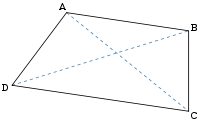- Trapezoid
-
For other uses, see Trapezoid (disambiguation) and Trapezium (disambiguation).
Trapezoid (AmE)
Trapezium (BrE)
A TrapezoidType quadrilateral Edges and vertices 4 Area 
Properties convex In Euclidean geometry, a convex quadrilateral with one pair of parallel sides is referred to as a trapezoid in American English and as a trapezium in English outside North America. A trapezoid with vertices ABCD is denoted
 ABCD or ⏢ ABCD. The parallel sides are called the bases of the trapezoid.
ABCD or ⏢ ABCD. The parallel sides are called the bases of the trapezoid.This article uses the term trapezoid in the sense that is current in the United States (and sometimes in some other English-speaking countries)[citation needed]. Readers in the United Kingdom and Australia should read trapezium for each use of trapezoid in the following paragraphs. In all other languages using a word derived from the Greek for this figure, the form closest to trapezium (e.g. French 'trapèze', Italian 'trapezio', German 'Trapez', Russian 'трапеция') is used.
The term trapezium has been in use in English since 1570, from Late Latin trapezium, from Greek trapezion, literally "a little table", diminutive of trapeza "table", itself from tra- "four" + peza "foot, edge". The first recorded use of the Greek word translated trapezoid (τραπεζοειδη, table-like) was by Marinus Proclus (412 to 485 AD) in his Commentary on the first book of Euclid’s Elements.[1]
Contents
Definition
There is also some disagreement on the allowed number of parallel sides in a trapezoid. At issue is whether parallelograms, which have two pairs of parallel sides, should be counted as trapezoids. Some authors[2] define a trapezoid as a quadrilateral having exactly one pair of parallel sides, thereby excluding parallelograms. Other authors[3] define a trapezoid as a quadrilateral with at least one pair of parallel sides, making the parallelogram a special type of trapezoid (along with the rhombus, the rectangle and the square). The latter definition is consistent with its uses in higher mathematics such as calculus. The former definition would make such concepts as the trapezoidal approximation to a definite integral be ill-defined.
Special cases
In an isosceles trapezoid, the base angles have the same measure, and the other pair of opposite sides AD and BC also have the same length.
In a right trapezoid, two adjacent angles are right angles.
Characterizations
A convex quadrilateral is a trapezoid if and only if it has two adjacent angles that are supplementary, that is, they add up 180 degrees.
Another necessary and sufficient condition is that the diagonals cut each other in mutually the same ratio (this ratio is the same as that between the lengths of the parallel sides).
A convex quadrilateral is also a trapezoid if and only if the diagonals form one pair of similar opposite triangles
Area
The area K of a simple (that is, not self-intersecting) trapezoid is given by[3]
where a and b are the lengths of the parallel sides, and h is the height (the perpendicular distance between these sides.) In 499 CE Aryabhata, a great mathematician-astronomer from the classical age of Indian mathematics and Indian astronomy, used this method in the Aryabhatiya (section 2.8).[4] This yields as a special case the well-known formula for the area of a triangle, by considering a triangle as a degenerate trapezoid in which one of the parallel sides has shrunk to a point.
The mid-segment of a trapezoid is the segment that joins the midpoints of the non-parallel sides. Its length m is equal to the average of the lengths of the bases of the trapezoid:
It follows that the area of a trapezoid is equal to the length of this mid-segment multiplied by the height:
In the case that the two parallel sides are different lengths (a ≠ b), the height of a trapezoid h, and hence its area A can be determined by the length of all of its sides:
where, c and d are the lengths of the other two sides, and hence
When one of the parallel sides has shrunk to a point (say a = 0), this formula reduces to Heron's formula for the area of a triangle.
Another equivalent formula for the area, which more closely resembles Heron's formula is:
where
is the semiperimeter of the trapezoid. (This formula is similar to Brahmagupta's formula, but it differs from it, in that a trapezoid might not be cyclic (inscribed in a circle). The formula is also a special case of Bretschneider's formula for a general quadrilateral).
Therefore using Bretschneider's formula gives:
The centre of area (centre of mass for a uniform lamina) lies along the line joining the mid-points of the parallel sides, at a perpendicular distance d from the longer side b given by

Properties
The line joining the mid-points of the parallel sides bisects the area.
If the trapezoid is divided into 4 triangles by its diagonals AC and BD (as shown on the right), intersecting at O, then the area of
 AOD is equal to that of
AOD is equal to that of  BOC, and the product of the areas of
BOC, and the product of the areas of  AOD and
AOD and  BOC is equal to that of
BOC is equal to that of  AOB and
AOB and  COD. The ratio of the areas of each pair of adjacent triangles is the same as that between the lengths of the parallel sides.
COD. The ratio of the areas of each pair of adjacent triangles is the same as that between the lengths of the parallel sides.Therefore the diagonal length is
Let the trapezoid have vertices A, B, C, and D in sequence and have parallel sides AB and DC. Let E be the intersection of the diagonals, and let F be on side DA and G be on side BC such that FEG is parallel to AB and CD. Then FG is the harmonic mean of AB and DC:
If M and N are the midpoints of the diagonals, then
where a and b are the lengths of the parallel sides.
If the angle bisectors to angles A and B intersect at P, and the angle bisectors to angles C and D intersect at Q, then[5]
The line joining the point where the nonparallel sides intersect and the intersection point of the diagonals bisect each base.[5]
Terminology
The the term trapezium is sometimes defined in the USA as a quadrilateral with no parallel sides, though this shape is more usually called an irregular quadrilateral.[6][7]. The term trapezoid was once defined as a quadrilateral without any parallel sides in Britain and elsewhere, but this does not reflect current usage. (The Oxford English Dictionary says “Often called by English writers in the 19th century".)[8]
According to the Oxford English Dictionary, the sense of a figure with no sides parallel is the meaning for which Proclus introduced the term "trapezoid". This is retained in the French "trapézoïde", German "Trapezoid", and in other languages. A trapezium in Proclus' sense is a quadrilateral having one pair of its opposite sides parallel. This was the specific sense in England in 17th and 18th centuries, and again the prevalent one in recent use. A trapezium as any quadrilateral more general than a parallelogram is the sense of the term in Euclid. The sense of a trapezium as an irregular quadrilateral having no sides parallel was the sometimes used in England from c1800 to c1875, but is now obsolete. This sense is the one that is sometimes quoted in the U.S., but in practice quadrilateral is used rather than trapezium.[8]
 The Temple of Dendur in the Metropolitan Museum of Art, New York
The Temple of Dendur in the Metropolitan Museum of Art, New York
Architecture
In architecture the word is used to refer to symmetrical doors, windows, and buildings built wider at the base, tapering towards the top, in Egyptian style. If these have straight sides and sharp angular corners, their shapes are in fact isoceles trapezoids.
See also
- Isosceles trapezoid
- Parallelogram
- Polite number, also known as a trapezoidal number
- Trapezoidal rule
References
- ^ Oxford English Dictionary entry at trapezoid.
- ^ "American School definition from "math.com"". http://www.math.com/school/glossary/defs/trapezoid.html. Retrieved 2008-04-14.
- ^ a b Weisstein, Eric W., "Trapezoid" from MathWorld.
- ^ Aryabhatiya Marathi: आर्यभटीय, Mohan Apte, Pune, India, Rajhans Publications, 2009, p.66, ISBN 978-81-7434-480-9
- ^ a b Owen Byer, Felix Lazebnik and Deirdre Smeltzer, Methods for Euclidean Geometry, Mathematical Association of America, 2010, p. 55.
- ^ Chambers 21st Century Dictionary Trapezoid
- ^ "1913 American definition of trapezium". Merriam-Webster Online Dictionary. http://www.merriam-webster.com/dictionary/trapezium. Retrieved 2007-12-10.
- ^ a b Oxford English Dictionary entries for trapezoid and trapezium.
External links
- Trapezoid definition Area of a trapezoid Median of a trapezoid With interactive animations
- Trapezoid (North America) at elsy.at: Animated course (construction, circumference, area)
- [1] on Numerical Methods for Stem Undergraduate
- Autar Kaw and E. Eric Kalu, Numerical Methods with Applications, (2008) [2]
Categories:- Quadrilaterals
- Elementary shapes
Wikimedia Foundation. 2010.














